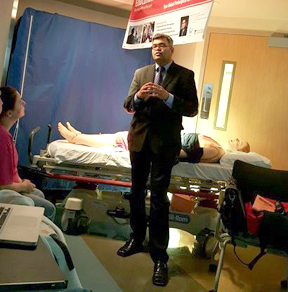
ODESSA, TX: The First Responder Trauma and Emergency Care Program, created by Dr. Dinesh Vyas, a professor of surgery at TTUHSC, seeking to address trauma problem through educational efforts directed at lay person first responders in rural settings, has as much relevance here as back home in India.
The trauma related accidents tend to cause more severe injuries and more frequent fatalities in rural environments than their urban counterparts in the United States. This is, in part, due to a lack of appropriate critical care education of first responders in rural settings.
The First Responder Trauma and Emergency Care Program is a four-tier education program and uses online platform, high end simulation and mock drills in addition to an interactive model of lectures delivered by Dr. Vyas, followed by breakout sessions where program participants practice the skills discussed in simulation environments.
Dr. Vyas has routinely conducted these sessions across eight different international locations to date, under the umbrella of Vyas Global Pre-hospital Care Education Initiative and plans on expanding to 3 more locations within the state of Texas.
On March 26, Dr. Vyas led the inaugural session in Odessa, Texas, to test proof of concept of this type of training being useful in West Texas. The inaugural program was highly successful, and had 32 participants from Midland Police, Midland Fire Department, students from Odessa and Midland area schools, PA students, first, second, third and fourth year medical students, family medicine residents, ER nurses, and laypeople from the oil industry. In addition, the program incorporated a trainer’s orientation course as well. Trainers included TTUHSC faculty from pediatrics, the nursing college, PA school, simulation educators, and trauma leaders.
This program was felt to be useful by all participates as indicated by their responses in video interviews conducted after the session. A scientific study was also conducted after institutional review board approval, and the initial analysis of the data from the study is highly encouraging. Based on the data, new strategies are being developed on how to best use the participants from this session to implement future sessions on a much larger scale.
This initial assessment points towards the First Responder Trauma and Emergency Care Program being a worthwhile effort in the West Texas demographic. Future efforts will include recreation of this session in the cities of Lubbock and Amarillo, further analysis of data points collected from these additional sessions, and determination of what additional locations would benefit from these sessions.
Lessons learned from these additional sessions could be used to implement similar programs for first responders across the rural United States.
India Post News Service






